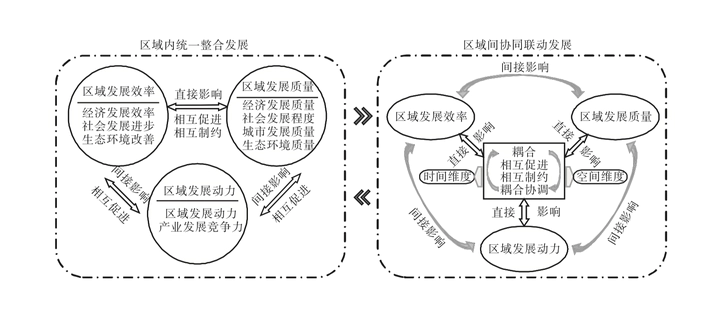The Formation Mechanism of China’s New Pattern of Regional Development in the New Era: Based on the Evolutionary Economic Analysis of the Ternary System of “Dynamic-Efficiency-Quality” [in Chinese]
Abstract: The theoretical framework for constructing a new pattern of regional development in China in the new era is of great significance for promoting high-quality development. Based on the perspective of evolutionary economic analysis, this paper discusses the formation mechanism of China©s new pattern of regional development by analyzing the evolutionary economic characteristics of the ternary system of dynamic,efficiency and quality.
We apply the Differential Shift Analysis,EBM and TOPSIS of entropy weight to measure the level of dynamic,efficiency and quality of China©s regional development,and use Coupling Coordination Degree Model and Panel Error Correction Model to evaluate the coordinated evolution characteristics and mechanism. The results find that since the reform and opening up,dynamic,efficiency and quality of China©s regional development presents the development trend of “benign resonance coupling,extremely coordination”,exists error correction mechanisms,and has obvious circular cumulative causation effect.
The marginal contribution is as follows:First,we construct the “R-DEQ” formation framework of China©s new pattern of regional development under the theoretical framework of evolutionary economics. Second,this paper emphasizes the significance of combining the ternary system of dynamic,efficiency and quality of regional development,two levels of intra- and inter-region,two dimensions of time and spatial,and two channels of direct and indirect mechanism. Third,this paper provides theoretical guidance and path selection for China to form the mechanism of China©s new pattern of regional development.
构建新时代中国区域发展新格局的理论框架,对于推进高质量发展具有重要意义。基于“动力-效率-质量”三元体系演化经济分析视角,本文通过综合运用竞争力偏离、非期望EBM和熵权TOPSIS评估中国区域发展动力、效率和质量的历史水平,并采用耦合协调度与面板误差修正模型从时空视域探讨其协同演变特征及作用机制。研究表明,改革开放以来,中国区域发展“动力-效率-质量”三元体系呈现“良性共振耦合、极度协调耦合”的发展态势,并存在相互作用的误差修正机制,且具有明显的循环累积因果效应。在演化经济学理论框架下,本文突破传统区域协调发展机制藩篱,从区域发展“动力-效率-质量”三元体系、区域内与区域间两个层面、时间与空间两个维度以及直接与间接两个渠道,系统构建了中国区域发展新格局的“R-DEQ”理论框架,为加快形成新时代中国区域发展新格局,特别是做大做强“内循环”并实现经济社会高质量、可持续发展,提供理论框架和路径选择。
基金项目
国家社会科学基金重大项目“新时代绿色发展绩效评估与美丽中国建设道路研究”(18ZDA047)
国家自然科学基金优秀青年项目“空间计量经济学建模与分析” (72222007)
国家自然科学基金面上项目“基于时变空间系数和内生权重空间面板模型的地方政府策略互动研究”(71973097)
作者简介
郑维伟,上海交通大学安泰经济与管理学院(邮编:200030),E-mail:vivid_zheng@sjtu.edu.cn
瞿茜,上海交通大学安泰经济与管理学院(邮编:200030),E-mail:xiqu@sjtu.edu.cn
刘耀彬,南昌大学经济管理学院(邮编:330031),E-mail:liuyaobin2003@163.com
汪元盛,南开大学金融学院(邮编:300350),E-mail: yuanshengwang@mail.nankai.edu.cn
